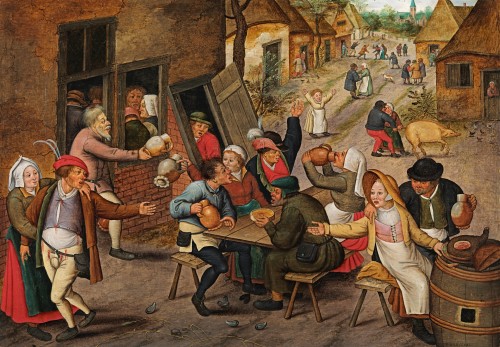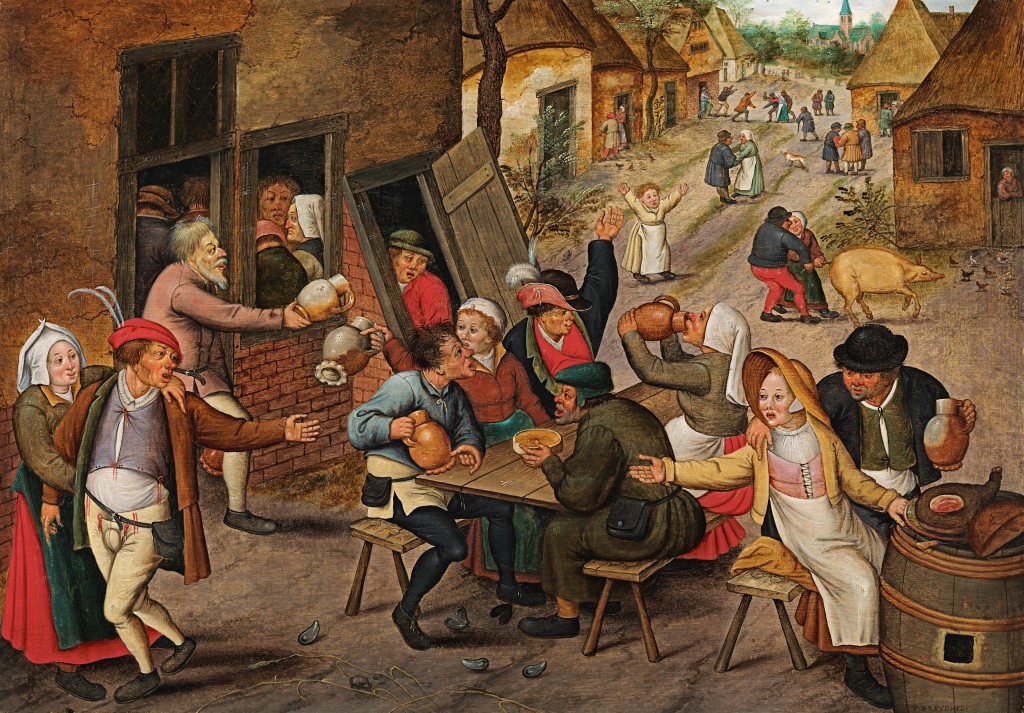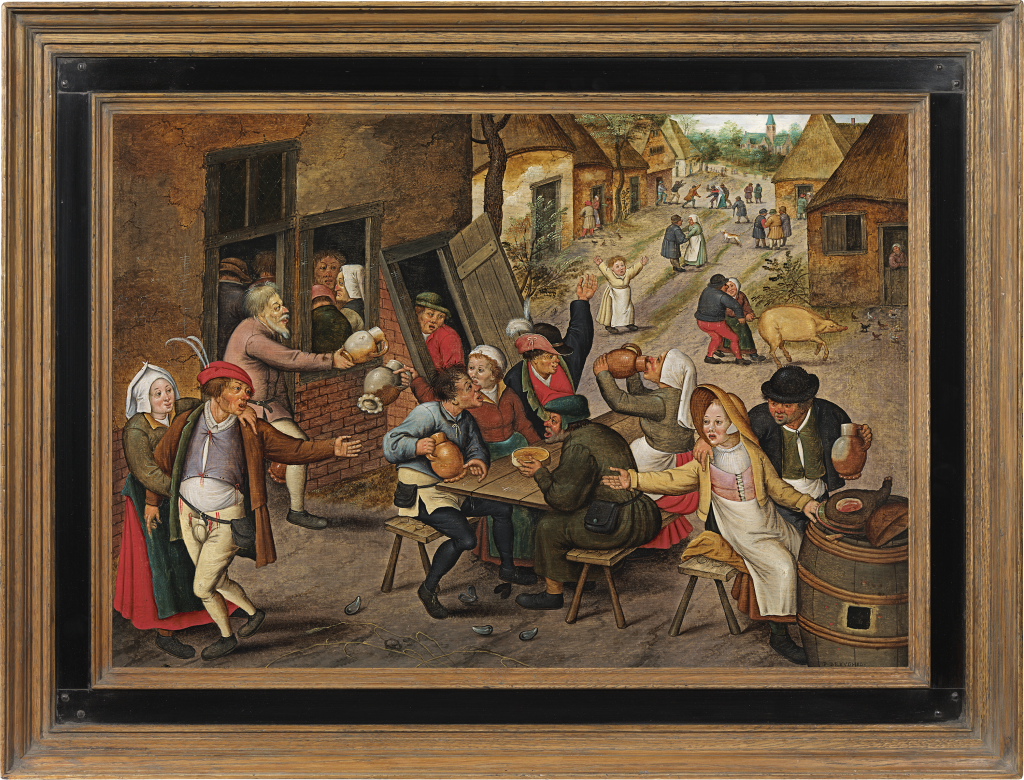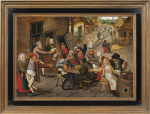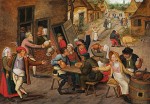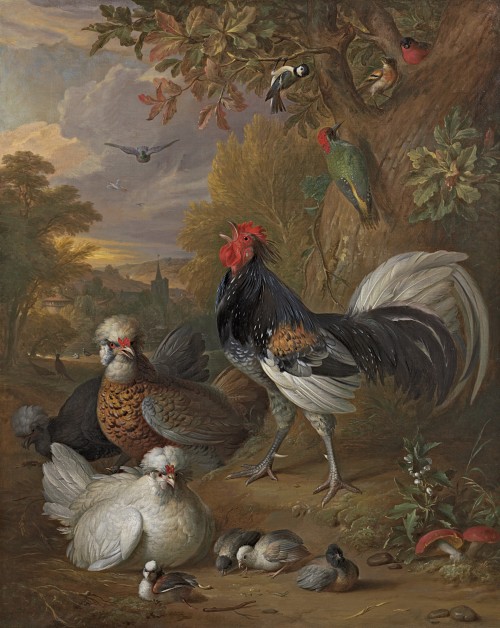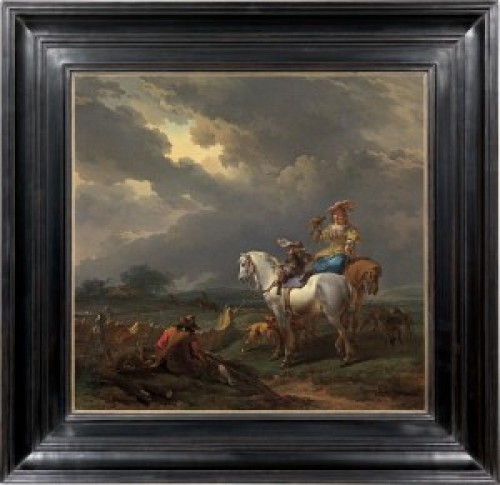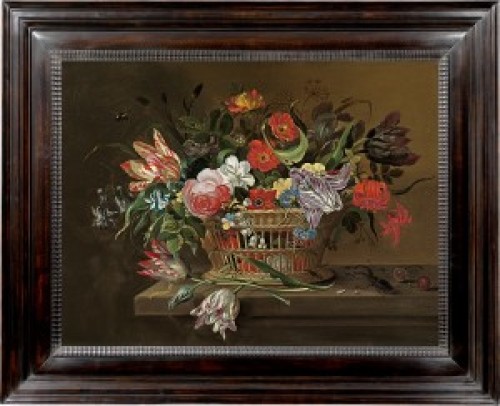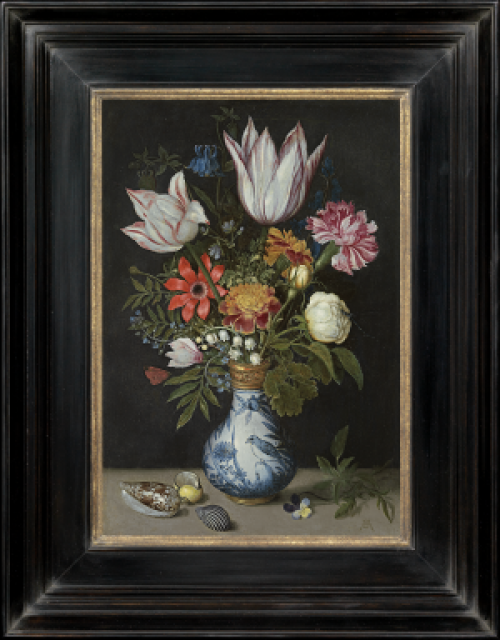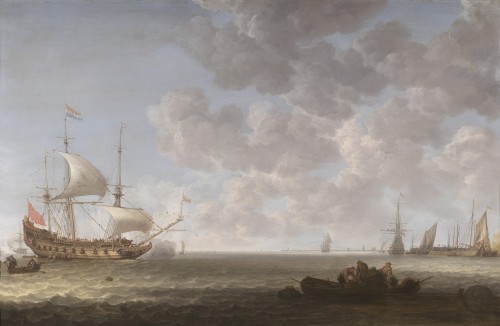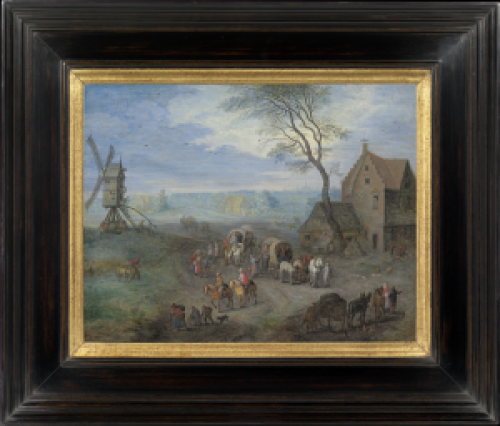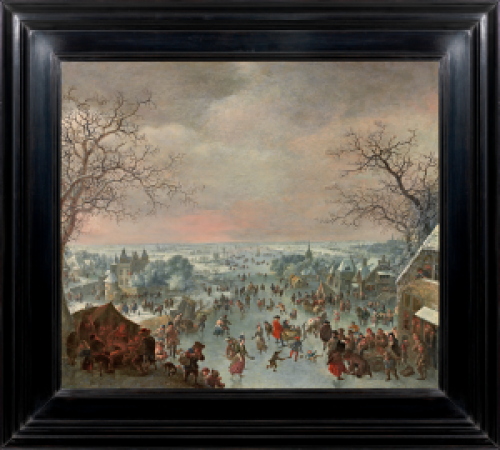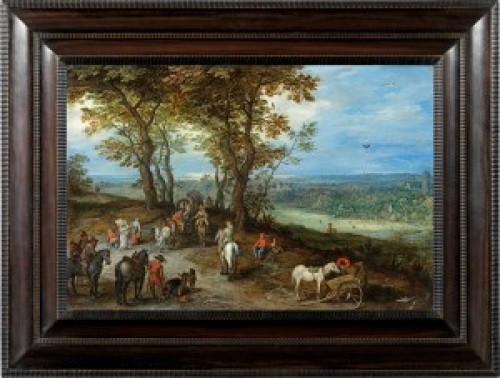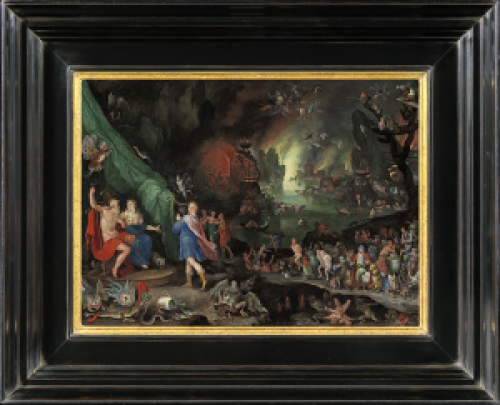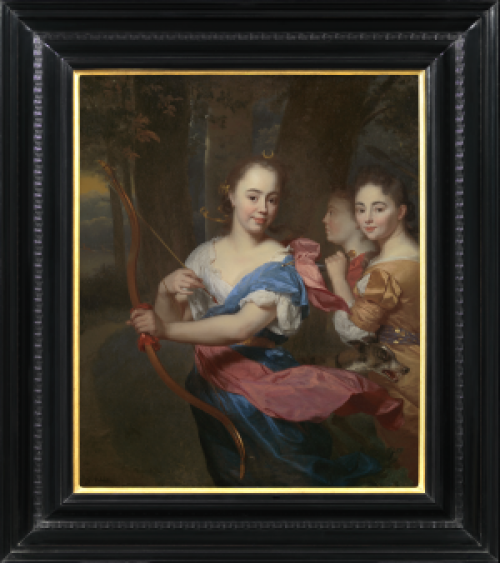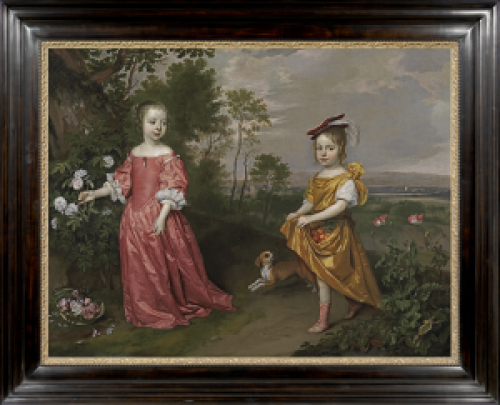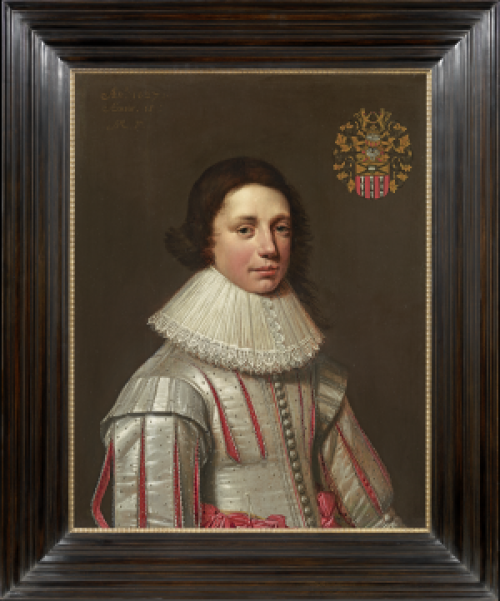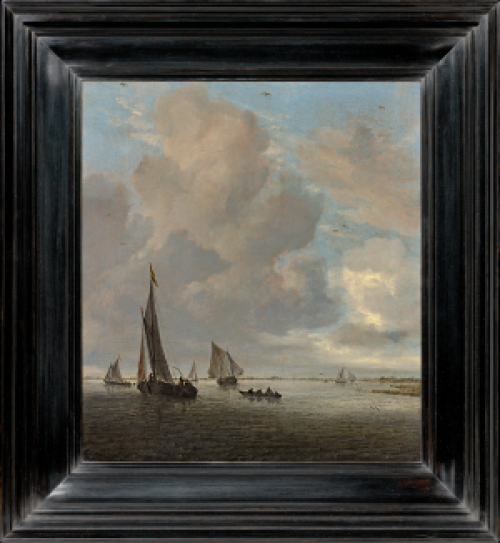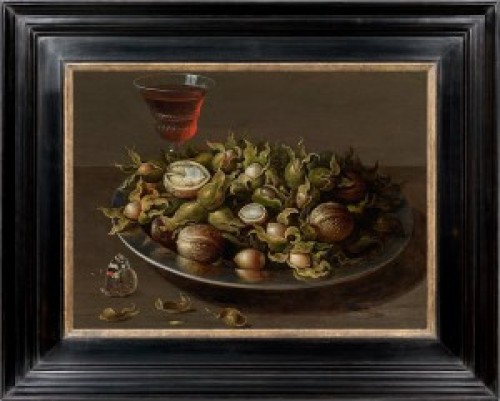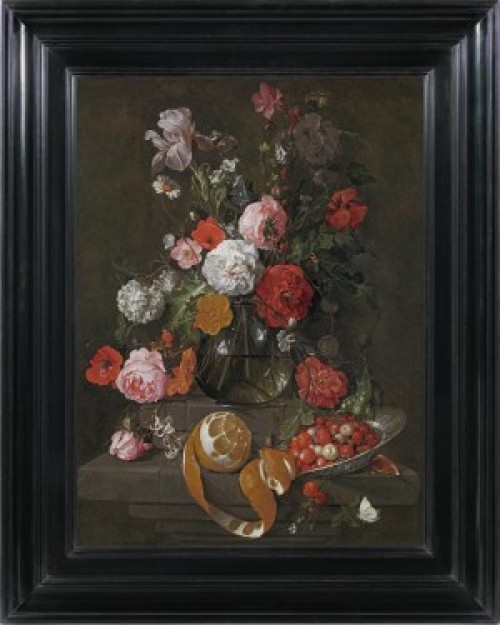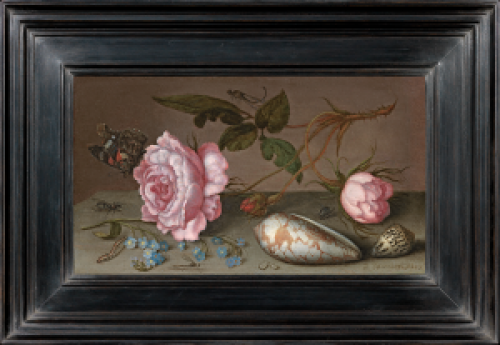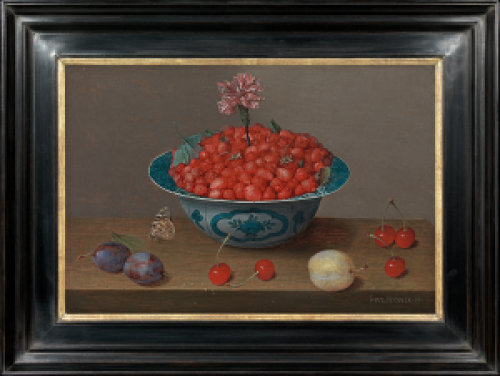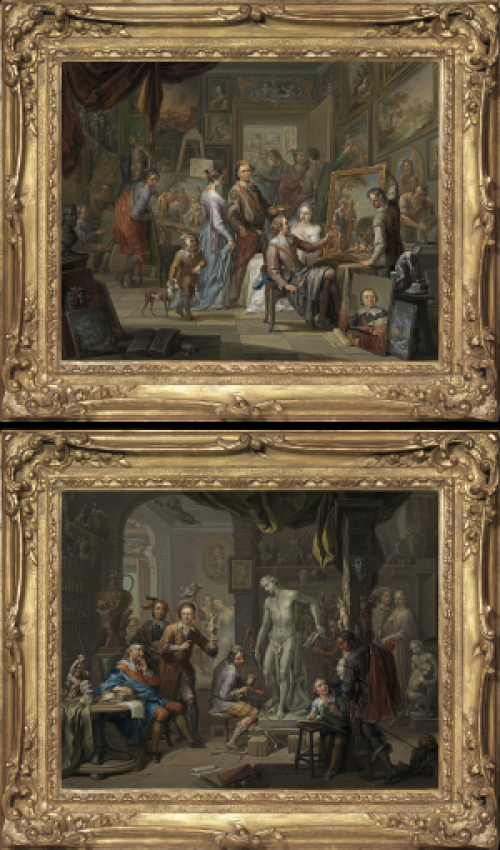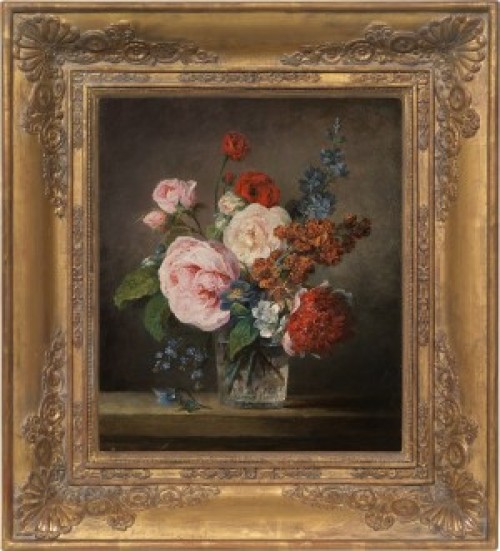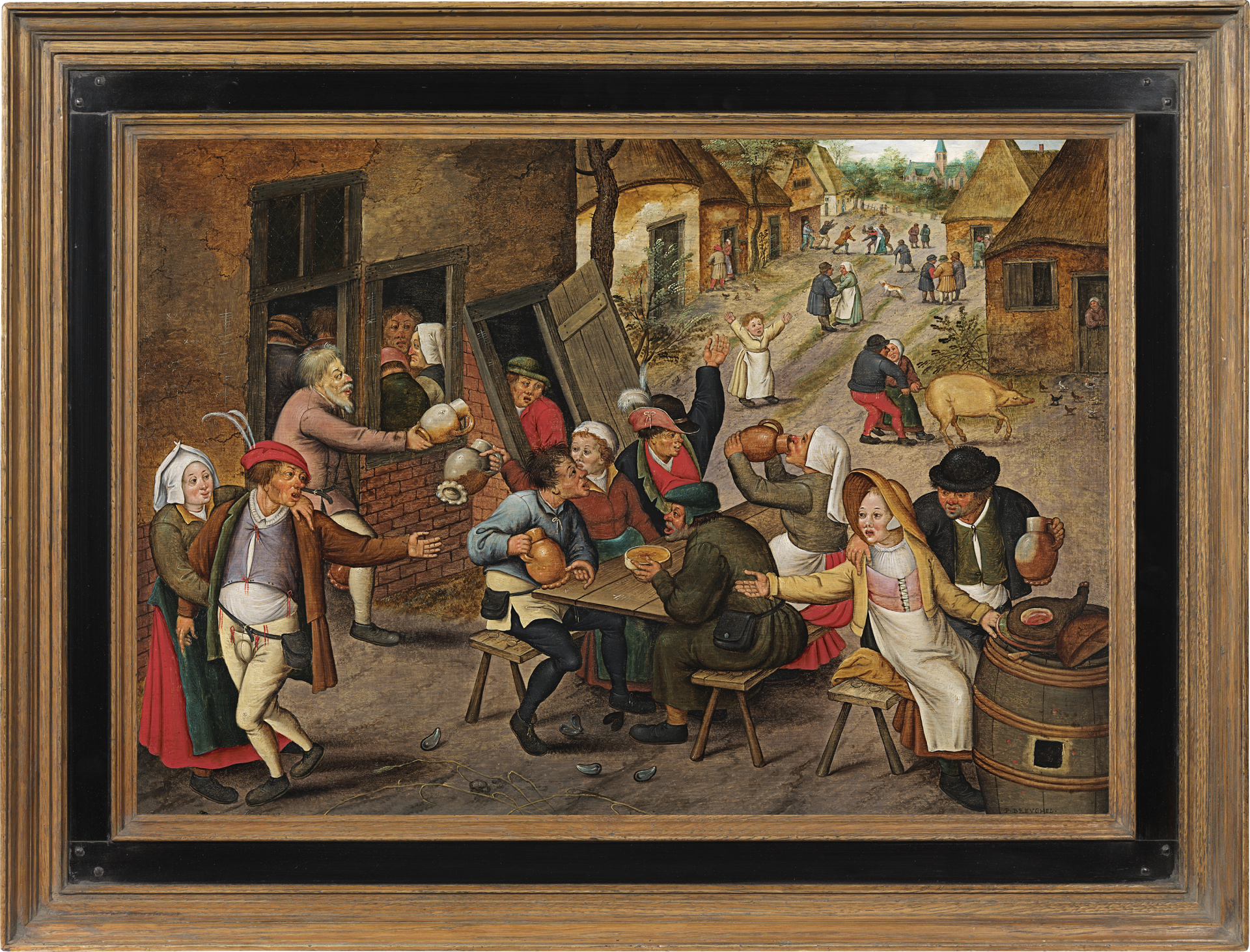PIETER BRUEGHEL THE YOUNGER
Brussels Brussels 1564/5 - 1637/8 Antwerp
Ref: CA 200
The Swan Inn: peasants feasting and merrymaking in a village street
Signed lower right: P BREVGHEL
Oil on panel: 17 ¼ x 24 5/8 in / 43.8 x 62.5 cm;
the reverse incised with the panel maker’s mark of Michiel Vrient (fl.1615-1637) and branded with the coat of arms of the City of Antwerp, the mark of the Antwerp panel makers’ guild
Frame size: 23 ½ x 31 in / 59.6 x 78.7 cm
Painted circa 1626
Provenance:
Jacques Hynderick de Ghelcke (1891-1975), by 1905;
by descent in a noble collection;
Sotheby’s London, 9th March 1983, lot 10;
where acquired by a private collector, Europe
Literature:
Klaus Ertz, Pieter Brueghel der Jüngere (1564-1637/38): Die Gemälde mit Kritischem Oeuvrekatalog, Lingen 1988/2000, vol. II, pp.845-6, no.E1182 (as Das wirtshaus zum Schwan, with incorrect illus.)
Pieter Brueghel the Younger was the elder son of the famed Pieter Bruegel the Elder (c.1525/30-1569), the hugely innovative creator of peasant scenes, religious subjects and acutely-observed landscapes, such Hunters in the snow, 1565 (Kunsthistorisches Museum, Vienna). Most of Pieter I’s paintings disappeared into princely collections and Pieter II became the conduit for the dissemination of his father’s oeuvre, although he was only four when his father died and there are some sixteen years between Pieter II’s first works and his father’s death. Pieter II knew his father’s work intimately from a small number of original paintings and many prints. He made copies of many of his father’s most celebrated works, such as the Winter landscape with skaters and a bird trap, 1565 (Musée d’Art Ancien, Brussels).
In his later career Pieter Brueghel the Younger developed his own lively compositions of peasant life. Peasants feasting and merrymaking in a village street, which Klaus Ertz dates circa 1625, is a highly accomplished example from this phase, described by Ertz as ‘von hervorragender malerischer Qualität’ (‘of outstanding pictorial quality’)[1]. Its excellent state of preservation reveals Pieter’s skill as a draughtsman and the dynamism with which he orchestrates a scene with multiple figures.
With wry humour, Brueghel depicts a village feast which is spiralling gently out of control. The tipsy revellers call for more beer: as fast as it is produced from the inn cellar, an empty jug is sent back to be refilled. The foreground drama, left and right, is provided by a pair of couples. A man and a woman lock eyes in an expression of woozy affection, while their more sober partners restrain them, arousing curiosity about the true relationships of these neighbours and friends. Down the long village street are more incidents – an escaped pig, a remonstrating couple and a fight breaking out. The village dogs are having no end of a good time, running about and barking at all this chaos.
The village church in the background is a reminder that the licence of Carnival and other feasts was an exception to the everyday world of hard work and piety, a necessary letting-off of steam in the ordered agricultural year. However, as always with Pieter II, enjoyment of the joie de vivre of peasant life softens the moral overtones. This exuberance is apparent in the variety of gestures and the rich and subtle palette of oxblood red, scarlet, slate blues, moss greens, lilac, gold, straw colour and creamy white which moves the eye constantly across the painting, encompassing every detail.
Compared to the myriad figures of Brueghel’s earlier work, the peasants in this composition are particularly large and exquisitely detailed. Two of the men sport jaunty feathered hats, while the woman at foreground right has her face framed in a broad-brimmed straw hat. The group of figures at the table, along with the prominent figures either side, were probably taken from a cartoon, either by pouncing that was later erased, or by tracing. The landscape and background figures are very freely drawn. Small details, such as the tally marks for the beer on the central table, the knife beneath the ham on the barrel and the chickens by the cottage, have no under-drawing and were painted spontaneously.
Seven other autograph versions of this composition are known[2]. In every case, as with the present work, Pieter spells his signature ‘Breughel’, the form which he used after 1616. The earliest known version of this design is the work sold at Christie’s Amsterdam on 14th November 1991, which is dated 1625. The last dated version is from 1632. In some versions of the subject the tavern is given a wooden sign, ‘In de swaen’ (The Swan Inn).
The reverse of the panel has the maker’s mark of the Antwerp panel maker Michiel Vrient (fl.1615-1637), who became a Master in the panel makers’ guild in 1615. His panels were used by many leading Flemish painters, including Pieter’s brother Jan Brueghel the Elder, Peter Paul Rubens, Anthony van Dyck, David Teniers, Frans Snyders and Frans Francken the Younger.
Note on the panel maker’s mark by Professor Jørgen Wadum
The Antwerp coat of arms was branded on the reverse of this panel in such a way that the monogram (MV interlaced) of the panel maker Michiel Vriendt now appears positioned between the hands of the brand. The design of this branding iron—one of at least a dozen in use in early seventeenth century Antwerp—allows us to date the panel to between 1626 and 1637. This suggests that Pieter Brueghel II likely painted The Swan Inn: Peasants Feasting and Merrymaking in a Village Street sometime within this period.
Reference:
- Wadum, Jørgen. ‘The Antwerp Brand on Paintings on Panels’. In Looking Through Paintings, edited by Erma Hermens, vol. 11, pp.179–198. Archetype Publications Ltd., 1998.
The painting has been included in the Mark on Art database at the RKD, The Hague.
PIETER BRUEGHEL THE YOUNGER
Brussels 1564/5 - 1637/8 Antwerp
Pieter Brueghel the Younger was the first of Pieter Bruegel the Elder’s (c.1525/30-1569) two sons; his brother Jan Brueghel the Elder (1568-1625) was a flower and landscape painter. Born in 1564/5 in Brussels, Pieter II was trained by his grandmother, the watercolour and miniature painter Mayken Verhulst (1518-c.1596), the widow of Peter Coecke van Aelst who had taught his father. According to Karel van Mander, Pieter II may also have been taught by Gillis van Coninxloo III.
As the son of a Master, Pieter II was admitted as a Free Master to the Brussels St Luke’s Guild in 1584/5 and then settled in Antwerp, where he died in 1637/8. Pieter lived all his life in somewhat straitened circumstances; he neither owned his own house nor made the customary educational tour of Italy which his brother Jan undertook. He did, however, have a thriving atelier. Contemporary Antwerp inventories, such as that of the art dealer Forchoudt, frequently reference his copies of his father’s work. Pieter had at least nine pupils, among them the animal painter Frans Snyders and the genre painter Gonzales Coques.
Pieter Brueghel the Younger is particularly celebrated for his detailed scenes of peasant life, landscapes and religious subjects. Many of these are copies and adaptations of Pieter Brueghel the Elder’s work, such as Winter landscape with skaters and a bird trap and St John the Baptist preaching. Most of Pieter the Elder’s work had entered princely collections; Pieter II would have known it from a few paintings surviving in the family studios and a large number of engravings. Some of Pieter II’s compositions are important sources for lost works by Pieter I. In contrast with Pieter the Elder’s complex, satirical view of human nature, Pieter II’s works are more joyous and forgiving, with clear, bright colours.
In 1616 Pieter II changed the spelling of his name from ‘Brueghel’ to ‘Breughel’, a format which he used consistently thereafter. In his mature work he moved away from copies of his father’s work to develop his own compositions, many of them lively evocations of village life.
The work of Pieter Brueghel the Younger is represented in the Rijksmuseum, Amsterdam, the Musées Royaux des Beaux-Arts, Brussels; the Hermitage, St Petersburg; the Louvre, Paris; the National Gallery, London; the National Gallery of Art, Washington DC and the Metropolitan Museum of Art, New York.
[1] Ertz, 1988/2000, op. cit., vol. II, p.846, no.E1182.
[2] Ertz, ibid., vol. II, pp.845-6, E1179-E1181, E1183-E1186.

